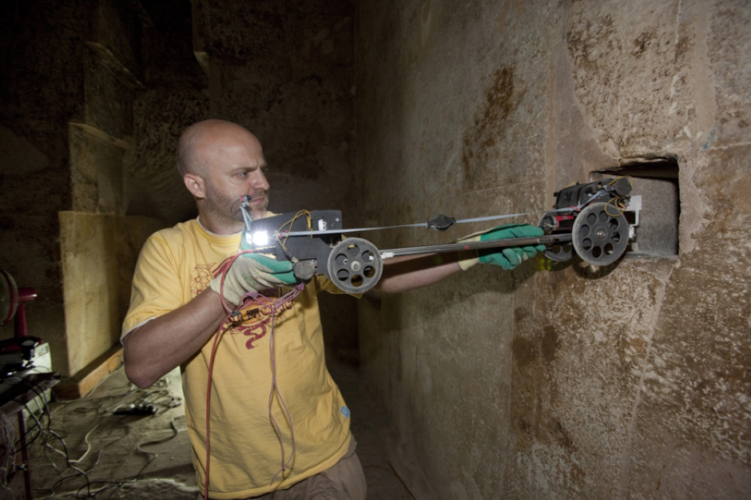
The Great Pyramid is thought to have been built around 4,500 years ago and is the biggest and oldest of the three pyramids that lie on the outskirts of Cairo.
CT scans and 3D printing give voice to mummified priest
Non-destructive archaeology finds military fort beneath Alcatraz prison
A number of archaeological teams have explored the pyramid, reaching a section dubbed the Queen’s Chamber. Those investigations revealed a narrow shaft behind a false wall that climbed at a 40-degree angle into the pyramid. They also resulted in damage to the shaft.
In 2010, Rob Richardson, Professor of Robotics at Leeds, was the technical lead of the Djedi expedition to explore the pyramid’s interior. Along with colleagues, he accepted a challenge from Hong Kong dentist and inventor Dr Tze Chuen Ng to design and build a robot that could survey the shaft without damaging the pyramid.
The robot would have to travel along a shaft measuring 20 cm by 20 cm and manoeuvre along its 60m length.
Professor Richardson, part of the Robotics at Leeds research group, said: “This design was certainly challenging. The robot had to be extremely lightweight – and in the end we got it down to 5kg. Because it was so light, it did not require a lot of power – in the end, the challenges started to become opportunities.
“We developed a system that moved the robot very gently through the passageway.”
The robot, which took five years to develop, was able to navigate the shaft and record footage of the inside with snake cameras.
Prof Richardson said: “No one knows the purpose of the shaft: there has been speculation that it could be an air vent or perhaps access to a burial tomb.
“About 50m along the shaft – several metres before what we think is the end, there is a stone put in place to block further access. We do not know what that stone is blocking access to. We were able to get a camera past the stone – it revealed a small chamber with intricate symbols painted onto the floor.
“Given the artwork, it is likely the shaft served a bigger purpose than act as an air shaft. But what that bigger purpose was remains a mystery.
“The robot’s camera also revealed a second blocking stone which they could not get past – so what lies beyond that second stone, at the end of the shaft, is a question that remains unanswered. The mystery of the Great Pyramid continues.”
Prof Richardson commissioned filmmaker William Westaway to use the video that had been recorded to make a film about the project. The documentary can be watched on the Ancient Architects channel on YouTube. To coincide with the release of the film, the scientists are making available all nine hours of the recorded video so it can be studied by archaeologists and ancient historians.




Project to investigate hybrid approach to titanium manufacturing
What is this a hybrid of? Superplastic forming tends to be performed slowly as otherwise the behaviour is the hot creep that typifies hot...